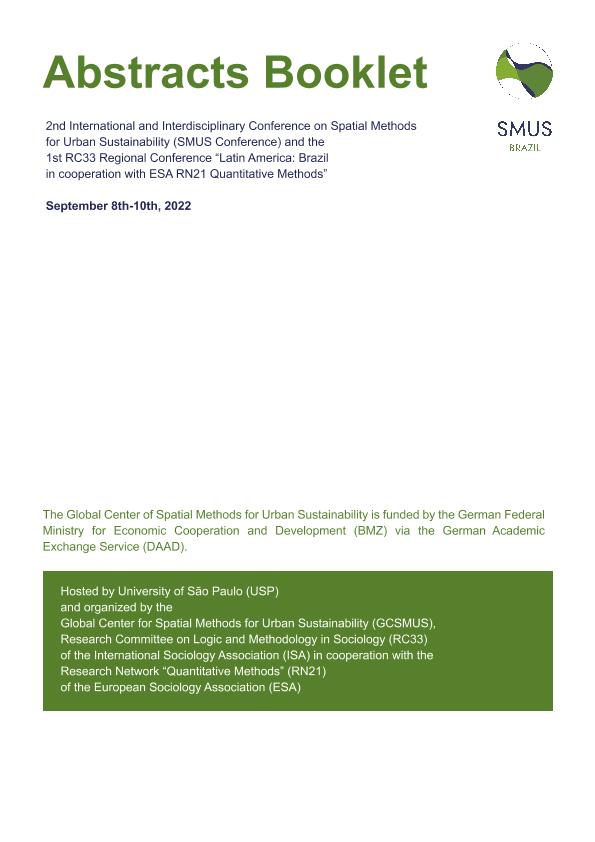Evento
Mapping the Urbanization Impact on a Regional Ecosystem: Historical Cartography on Invasion-Succession of Ligustrum lucidum in the Chaco Forest of Metro Córdoba (2001- 2022)
Tipo del evento:
Conferencia
Nombre del evento:
2nd International and Interdisciplinary Conference on Spatial Methods for Urban Sustainability; 1st RC33 Regional Conference “Latin America: Brazil in cooperation with ESA RN21 Quantitative Methods”
Fecha del evento:
08/09/2022
Institución Organizadora:
Global Center for Spatial Methods for Urban Sustainability;
Research Committee on Logic and Methodology in Sociology;
International Sociology Association;
Research Network “Quantitative Methods”;
European Sociology Association;
Título del Libro:
Abstracts Booklet “2nd International and Interdisciplinary Conference on Spatial Methods for Urban Sustainability" (“SMUS Conference”) and “1st RC33 Regional Conference – Latin America: Brazil”
Editorial:
University of São Paulo
Idioma:
Inglés
Clasificación temática:
Resumen
The Sierras Chicas valley (Córdoba, Argentina) has faced for years the invasion of the native forest by the exotic species Ligustrum lucidum (glossy privet). This problem is directly related to the urbanization processes in the region, specifically to urban forestry strategies that promote the implantation of exotic species - especially Ligustrum - whose evergreen foliage contrasts with the deciduous flora of this semi-arid region. In recent years, the affected area has growth significantly, causing drastic changes in the local ecosystem: Ligustrum reproduces quickly and competes successfully with the native flora for water and sunlight, causing the loss of the native flora and fauna. Several studies record the evolution of this process since 1983; this is essential to calculate the magnitude of the problem and the affected area over time. However, its evolution in the 21st century has not yet been reconstructed, even when in these years Sierras Chicas shows an exponential increase in its population and urbanized area, which would indicate a growing aggravation of the problem. Due to this, we propose to complete the historical record of the area occupied by Ligustrum between 2001 and 2022. To do this, we processed Landsat 8 and 9 satellite imagery obtained during dry season (between July- September), when the foliage difference between native forest and Lucidum is most notable: we calculated the different levels of the Normalized Difference Vegetation Index in the territory, detecting both areas covered with Ligustrum and urbanized areas in 2001, 2006, 2010, 2016 and 2022 with great level of detail and reliability. The selection of temporary samples responds to obtaining data with a periodicity according to the dynamic condition of the problem and generates information synchronous to the national population censuses (2001, 2010 and 2022); we also work with hydrographic cartography and Digital Elevation Models, to identify trends linked to topographic and hydrographic conditions. Integrating these variables in a Multicriteria Matrix - through the use of GIS - allows us to integrate environmental, spatial, and socioeconomic variables to study the close relationship between invasion-succession patterns and urbanization patterns. Our approach reconstructs this problem as a complex and dynamic process, from which it is possible to infer medium-term development trends. Through this transdisciplinary analysis, a critical environmental process becomes a direct indicator of the capacity of urbanization to transform the landscape on a regional scale. This is strategic data, not only to develop more effective protocols to remedy the impact of the invasion on the native forest, but also to generate situated knowledge about the urban-environmental dynamics of (re)production of the regional landscape, promoting more sustainable regional policies.
Palabras clave:
NDVI
,
LIGUSTRUM LUCIDUM
,
LANDSAT
Archivos asociados
Licencia
Identificadores
Colecciones
Eventos(CIECS)
Eventos de CENTRO DE INVESTIGACIONES Y ESTUDIO SOBRE CULTURA Y SOCIEDAD
Eventos de CENTRO DE INVESTIGACIONES Y ESTUDIO SOBRE CULTURA Y SOCIEDAD
Citación
Mapping the Urbanization Impact on a Regional Ecosystem: Historical Cartography on Invasion-Succession of Ligustrum lucidum in the Chaco Forest of Metro Córdoba (2001- 2022); 2nd International and Interdisciplinary Conference on Spatial Methods for Urban Sustainability; 1st RC33 Regional Conference “Latin America: Brazil in cooperation with ESA RN21 Quantitative Methods”; São Paulo; Brasil; 2022; 156-157
Compartir




